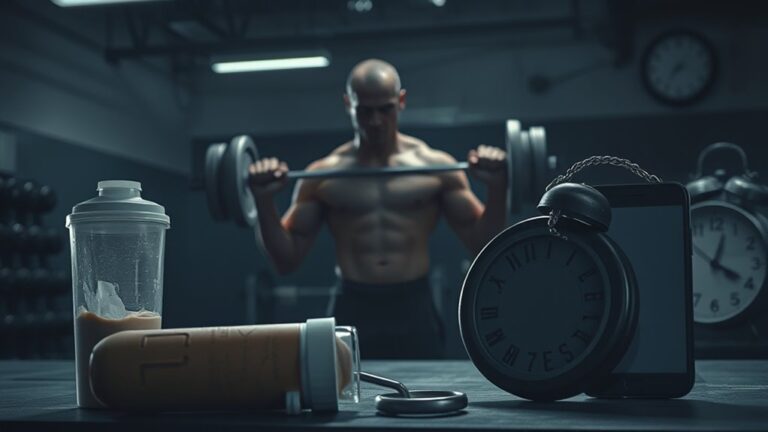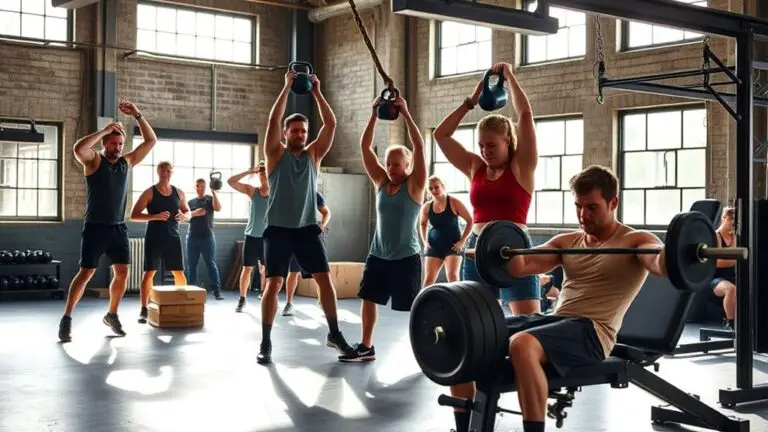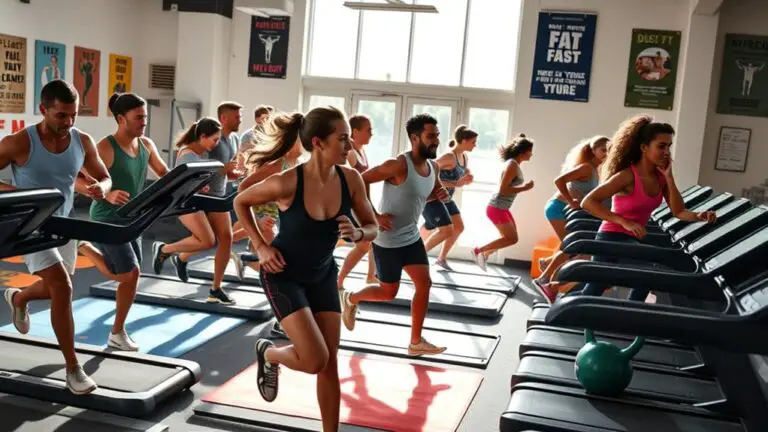Best Chest Exercises for Strength and Size

To build chest strength and size, include the barbell bench press as your foundation. Pair it with dumbbell flyes for isolation and flexibility, and use push-ups for bodyweight engagement. Incorporate incline dumbbell presses to target your upper chest and finish off with cable crossovers for a peak contraction effect. Remember, form and control are vital for all these exercises. Keep exploring for additional tips and techniques to maximize your chest workout.
Barbell Bench Press

The barbell bench press is a cornerstone exercise for building chest strength and size. To perform it safely, you need to master proper barbell technique. Start by lying flat on your back, feet firmly on the ground, and grip the barbell slightly wider than shoulder-width. Keep your elbows tucked at about a 45-degree angle during the press to protect your shoulders.
Before you jump into heavier weights, focus on mastering the movement with lighter loads. This gradual weight progression helps you build strength without risking injury. Always have a spotter if you’re lifting heavier—this adds an extra layer of safety. Remember to warm up adequately and stretch your chest and shoulders before starting. Pay attention to your form, and if you feel any discomfort, stop immediately. With consistent practice and a focus on safety, you’ll see significant improvements in your chest strength and size over time. Incorporating jump rope exercises can also enhance your overall fitness and support your strength training goals.
Dumbbell Flyes
Dumbbell flyes are an excellent isolation exercise that targets the chest muscles, enhancing both strength and definition. When performed correctly, the benefits of dumbbell flyes include improved flexibility and a greater stretch of the chest, which can lead to muscle growth. To guarantee safety and effectiveness, it’s vital to maintain proper form. Start by lying on a flat bench with a dumbbell in each hand, arms extended above your chest. Lower the weights slowly and with control, keeping a slight bend in your elbows. Your elbows should remain at the same angle throughout the movement. Avoid letting the weights drop too low to prevent shoulder strain. As you lift the dumbbells back to the starting position, focus on squeezing your chest muscles. Remember, quality over quantity is key—perform fewer reps with proper form rather than rushing through more reps incorrectly.
Push-Ups

Push-ups are one of the most effective bodyweight exercises for building chest strength and size. They’re accessible, requiring no equipment, and can be modified to suit your fitness level. However, proper technique is essential to guarantee safety and effectiveness.
Here’s a quick overview of variations, techniques, benefits, and drawbacks:
| Variation | Benefits | Drawbacks |
|---|---|---|
| Standard Push-Up | Builds overall strength | Can strain wrists if done incorrectly |
| Incline Push-Up | Easier for beginners | Less challenge for advanced lifters |
| Decline Push-Up | Targets upper chest | Requires stability and strength |
| Diamond Push-Up | Engages triceps more | Can be tough on shoulders |
| Wide Grip Push-Up | Works outer chest | May cause discomfort if overextended |
Incorporating these variations into your routine can maximize your results while minimizing potential injury. Always listen to your body!
Incline Dumbbell Press
An incline dumbbell press is a fantastic exercise for targeting the upper chest while also engaging the shoulders and triceps. To maximize muscle activation and guarantee safety, follow these form tips:
- Set the Bench: Adjust the bench to a 30-45 degree angle. This angle effectively targets the upper chest and minimizes shoulder strain.
- Grip and Position: Hold the dumbbells with a neutral grip, palms facing each other. Keep your elbows at about a 45-degree angle from your body to protect your shoulders.
- Controlled Movement: Lower the dumbbells slowly, ensuring they come down to chest level. Press back up in a controlled manner, fully extending your arms without locking your elbows.
Cable Crossovers

After you’ve mastered the incline dumbbell press, incorporating cable crossovers into your routine can further enhance your chest development. This exercise utilizes cable techniques to target your pectoral muscles effectively while promoting balanced muscle activation.
To perform cable crossovers safely, adjust the pulleys to shoulder height and make sure you’re using a weight that allows for controlled movement. Stand in the center, grasp the handles, and step forward slightly. As you pull the cables together in front of you, keep your elbows slightly bent—this helps protect your joints. Focus on squeezing your chest at the peak of the movement, then slowly return to the starting position.
Frequently Asked Questions
How Often Should I Train My Chest for Optimal Results?
Did you know that training your chest just twice a week can lead to significant muscle growth? For best results, aim for 2-3 chest training sessions weekly, allowing adequate recovery time of at least 48 hours between workouts. This frequency helps guarantee that your muscles can heal and grow stronger while reducing the risk of injury. Always listen to your body and adjust your routine to maintain safety and effectiveness in your training.
Should I Prioritize Strength or Size in My Chest Workouts?
When deciding whether to prioritize strength or size in your chest workouts, consider your goals. If you’re aiming for muscle hypertrophy, focus on higher reps with moderate weights. However, if strength training is your main goal, lower reps with heavier weights might be more effective. It’s essential to strike a balance to prevent injury, ensuring you include proper form and recovery in your routine. Always listen to your body and adjust accordingly for safety.
What Is the Best Warm-Up for Chest Exercises?
To warm up for chest exercises, you’ve got to get the ball rolling with some dynamic stretches and mobility drills. Start with arm circles and torso twists to loosen up those muscles and joints. Gradually increase your range of motion, ensuring your body’s ready for action. Don’t skip this vital step; it’ll help prevent injuries and enhance your performance. Remember, a good warm-up sets the stage for a successful workout.
Can I Train My Chest if I Have Shoulder Pain?
If you’re dealing with shoulder pain, it’s essential to approach chest training cautiously. You can train your chest, but prioritize shoulder rehabilitation and pain management. Focus on lighter weights and avoid exercises that exacerbate your discomfort. Consider consulting a healthcare professional or physical therapist for tailored advice. Always listen to your body—if something hurts, stop. Safety should be your top priority to prevent further injury while still working on your chest.
How Do I Track Progress in My Chest Workouts?
Imagine you’re like Sarah, who struggled to see gains in her chest workouts. To effectively track your progress, consider keeping a workout journal. Log exercises, weights, and reps each session. This’ll help you spot patterns and adjust your routine safely. You might notice you’re lifting heavier over time or achieving more reps, which indicates improvement. Consistent progress tracking not only motivates you but also guarantees you’re training smart and minimizing injury risks.





